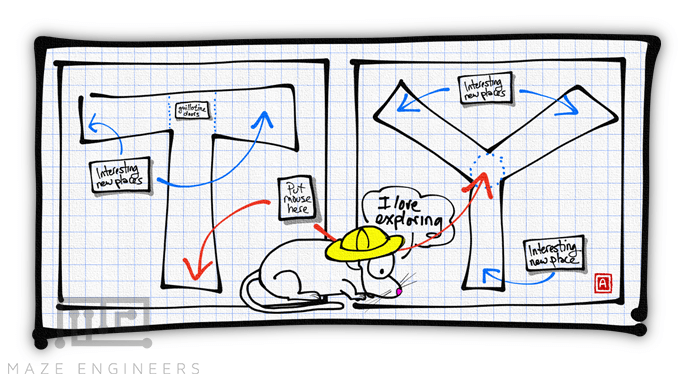Welcome back to the MazeEngineer Blog.
Last week we began our trip down memory lane by discussing how reference memory and working menory can be assessed with the 8-arm radial maze. This week, we’re going to consider the phenomenon of sponateous alternation, and how it is used in conjunction with the T-maze and the Y-maze to assess spatial memory.
First things first.
What is spontaneous alternation?
Spontaneous alternation behavior (SAB) is a fancy, sciency way of describing the natural tendency of animals (specifically mice/rats/rodents) to alternate which arms of a maze they choose to check out. Unlike the tests for reference and working memory that we discussed last week, when studying spatial memory through observation of spontaneous alternation behavior, the arms of the mazes do not contain any reward. Mice are simply put into the maze, allowed to explore, and their sequence of choices is recorded.
Well, it’s not really that simple. These days there are two main paradigms for studying SAB, and each is associated with a different maze. So, let’s talk about the mazes first, and then the paradigms.
The Mazes
T-maze: Mice are put into the base of the “T”, giving them two exciting new places to explore Fig. 1, left). This maze is usually used for 2-trial SAB paradigms.
Y-maze: Mice are put into the center of the “Y”, giving them access to three arms (Fig. 1, right). This maze is usually used in for continuous SAB paradigms.

Figure 1. The T-maze (left) and the Y-maze (right). Both mazes are used to investigate spatial memory by taking advantage of the natural inclination of mice to explore new regions of their environment. Note, the dotted circle in the Y-maze denotes the area the mice must return to before each choice, not guillotine doors that are present in the T-maze.
The Paradigms
Two-trial SAB:Typically a mouse is placed in a starting box at the base of the “T” and can freely choose one of the two arms. Once a choice is made (trial #1), the mouse is prevented from leaving the chosen arm. After the pre-determined intra-trial interval, the mouse is removed from the arm and placed back in the starting box. After a predetermined inter-trial interval, the mouse is again allowed to freely choose one of the two arms. If they choose the alternate arm (trail #2), it is scored as SAB (Fig. 2). This two-trial procedure is repeated several times, and the frequency of SAB typically declines.
The advantage of this setup is that it is very controlled, and several variables can be manipulated, and the effects on memory can be observed. For example, changing the length of the intra-trial interval may affect encoding memories, while changing the inter-trial interval may affect retention of spatial memory. Additionally, although not depicted in Figure 1, the initial choice in trial #1 can be forced by closing one of the doors from the outset. This usually creates stronger SAB in trial #2. On the down side, constant handling between trials in stressful for mice, and if they develop a fear of the arm from which they are removed, I will affect the results.

Figure 2. Two-trial spontaneous alternation using a T-maze. (1) A mouse wearing his explorer’s hat is placed in the base of the “T” (starting box not depeicted). Both arms are accessible. (2) Trial 1: The mouse chooses arm ‘A’, and the door closes. Mouse waits for overworked grad student to take him out of the maze. (3) Once out of the maze, the mouse waits to be put back at the starting point. (4) Trial 2: The mouse chooses arm ‘B’, completing one spontaneous alternation. The door closes, and the mouse waits again to begin another 2-trial adventure.
Continuous SAB: In this paradigm, mice are placed in the center of the “Y”, and given a set time (typically 8 min) to freely explore the three arms of the maze. As you might guess, calculating the SAB score is a bit more involved, but not really that difficult. Each choice is recorded, and the SAB score is determined by dividing the number of three successive choices that include one instance of each arm by the total number of opportunities for alternation (Fig. 3). Continuous SAB reduces the handling and stress of the animals at the cost being unable to manipulate factors that might influence memory performance.
Often, these tests are used to establish the behavior of KnockOut mice relative to normal mice, or how effectiveness a drug is at boosting spatial memory. However, when interpreting the results, one must keep in mind all the factors aside from memory that contribute to the behavior. For example, if an experimental manipulation causes animals to stop preferring novelty, then the resulting low SAB score should not be interpreted as a spatial memory deficit.
How have you used the Spontaneous alternation test? Any suggestions? Leave a comment below and let us know!
Hughes RN (2004). The value of spontaneous alternation behavior (SAB) as a test of retention in pharmacological investigations of memory. Neuroscience and biobehavioral reviews, 28 (5), 497-505 PMID: 15465137

